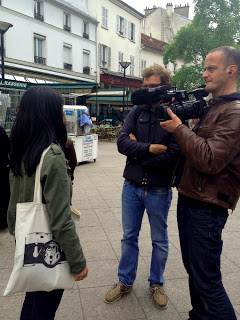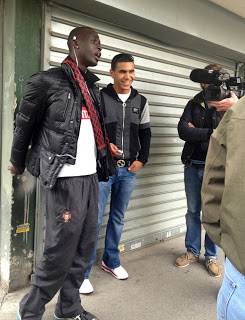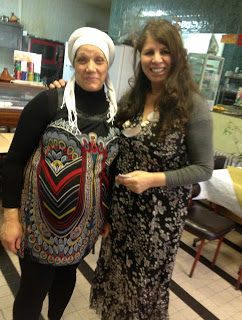| Some public housing units were interspersed with gardens and balconies, connected by curving pedestrian walkways. Photos by Sally Hamilton / The Rag Blog. |
Paris suburb defies expectations:
Visiting Aubervilliers in the ‘Red Belt’
Although Aubervilliers at night might be a scary proposition for an American senior with less than perfect French, it is safer than hundreds of places in the U.S. because the population doesn’t have guns.
By David P. Hamilton | The Rag Blog | June 20, 2013
PARIS — Recently my wife, Sally, and I accompanied our in-laws on an unusual Paris tour they had arranged. This tour took us to Aubervilliers, adjacent to Paris to the north, a site not one American tourist in a thousand chooses to visit.
Aubervilliers is in the center of the “Red Belt” north of Paris, a chain of working class towns adjacent to Paris in the “banlieu” (suburbs) that have been governed by the French Communist Party for decades.
Aubervilliers had Communist Party mayors continuously from WWII until 2008. It has a public housing project named after Julius and Ethel Rosenberg, Americans alleged to be Soviet spies who were executed by the U.S. government. Another large housing unit is named after Maurice Thorez, leader of the French Communist Party during its postwar prime. And it has a secondary school named after Rosa Luxemburg, martyred founder of the German Communist Party.
Located on the St. Denis Canal, Aubervilliers has been an industrial center since the early 19th century. It has been a melting pot for immigrants coming to the metropolis since then, at first from provincial France, now from almost everywhere, especially from Africa.
Roughly 40% of its population was born outside metropolitan France, and many of those born in France are second generation sons and daughters of immigrants. Our guide, Ingrid, told us that there are nearly 100 nationalities represented among its 80,000 inhabitants. Like her, many of the second generation are of mixed ethnic heritage. This town embodies diversity on steroids, besides being decidedly proletarian.
Aubervilliers is, however, more famous outside France as the scene of some of the worst poverty and rioting in recent French history. Communities of shacks called “bidonvilles” were photographed there in the 1950s as representative of the darkest side of the City of Light. By 1972, these slums were gone, replaced by public housing. In 2005, Aubervilliers was a major center of the rioting by young people protesting police brutality and job discrimination. Hundreds of cars were torched there, but no one was killed.
Most Americans with any awareness of the area have an image of vast, ugly, dirty, alienating public housing blocks with few amenities and poor transportation, filled with unemployed and disaffected people dealing drugs and inflicting violence on the more affluent who might wander into their midst. This image springs readily to the minds of Americans who are accustomed to the abysmally decrepit state and violent reputation of most urban public housing in the U.S.
Although we were only in Aubervilliers a few hours on a sunny spring day and we were being guided by a local, our impressions were quite different.
 |
| Olivier and Guillaume, our camera crew, interview our tour guide, Ingrid. |
Our guide, Ingrid, is a young women of Thai-French ancestry who is a native of Aubervilliers. She is a “greeter,” who volunteers to show tourists around her hometown. The way the “greeter” program works is that you make a nominal contribution to their organization and then they tell you what unconventional site you’re going to visit. This tour service to someplace you may have never heard of is otherwise free. We just lucked out getting Aubervilliers. Our expectations were to be challenged.
This private tour by four Americans was apparently so unique that it was filmed by a two-man crew under contract with a major French television channel that saw Americans in Aubervilliers as a rare and newsworthy event. So Olivier and Guillaume came along with their camera and microphone every foot of the way, shooting film and asking questions. Our tour became something of a moving spectacle as this miniature television crew followed us through town.
Although Aubervilliers has been around since at least 1069, this tour had nothing to do with medieval churches or civic monuments. Ingrid did point out an ancient wall that had been left standing as part of a public garden and an abandoned old paint factory, now a French “superfund” site. But these were just among the random sights as we walked through town on our way to meet her friends.
First we visited Julian at the “Association Freres Poussiere,” a small community arts facility. Julian showed us their art gallery-hangout space and theater and told us that the principal object of the center was to bring together Aubervilliers’ diverse groups in creative enterprises. Their facilities were humble, but their enthusiasm was strong and their explicit goal was multicultural harmony.
Next, our little group went up into the very bowels of one of those massive and supposedly dehumanizing public housing buildings to visit Fado, a 63-year-old woman from Senegal, bedecked for the occasion and probably all occasions in vibrantly colorful traditional Senegalese dress. She has been in France since the late 1970’s and has three children who were born here. Fado lived on the 18th floor.
Arriving at her building we found that one of the two elevators serving her sector of the building was broken and repairmen were busy repairing it. We were told that elevator breakdowns were not uncommon and that there had been times when both were broken simultaneously. Fado referred to other building maintenance complaints, but from our random visit, it appeared that the building was clean and reasonably well-maintained and the exterior nicely landscaped.
Fado’s apartment had two bedrooms, a living room, a kitchen with adjoining dining area, a bathroom, and storage space. The rooms were small by American standards, but not by Parisian standards. The apartment had roughly 7-800 square feet. It also had a great view, including Sacre Coeur and the Eiffel Tower.
Ingrid told us that Fabo paid rent, but it was on a sliding scale and quite reasonable. “Five hundred euros ($650) a month?,” we asked. “Less,” Ingrid responded.
Getting an apartment there requires proper qualifications (resident status plus low income or disability, etc) and some time on a waiting list. Fabo had lived in hers since the late 1980s. Her apartment was nice, clean and orderly, with a big flat-screen TV and comfortable leather couches in good condition in the living room. She served fruit juices and cookies. She had done domestic work for many years, but had been on disability due to a back injury for the past four. Her children were grown and lived elsewhere in the Paris area.
 |
| Brothers on the street. |
Other people we saw in the halls, on the elevator, and around the building were of every racial and ethnic type: white French ladies with their kids, black African and Arab ladies with their kids, old white mostly native French guys playing boules in the adjacent park, older Muslim men wearing skull caps, and a few orthodox Jews in their distinctive black suits and broad-brimmed hats strolling by, and mixed groups of idle young men of every complexion lounging around the grounds.
These people were generally well-dressed and friendly. No one looked especially poor and ragged or noticeably miserable or threatening. Unlike upscale central Paris, there were no homeless people living on the sidewalks and no beggars.
The groups of young men were of particular interest and concern. Under-30 unemployment is reputedly very high in Aubervilliers, maybe 50%. These are clearly the type of guys who have on occasion set a couple hundred cars on fire in protests. These are the guys who would reputedly have no livelihood were it not for the continuation of marijuana prohibition in France.
We were told that job seekers from this area lie about their zip codes when applying in Paris. These groups of young guys were thoroughly integrated, ranging from variations on white to very black, with a lot of North African Arab ancestry in the mix along with a few each of several varieties of Asians, plus growing numbers of “others,” such as our guide.
These guys were attracted by the filming, being done by two white native Frenchmen in their thirties, both over six-feet tall and fit. Our camera team interacted with these Aubervilliers street kids in a friendly and animated manner, but later told us that the situation was always delicate. You had to know how to act. Be outgoing and show no fear. Show them you’re on the same side. Otherwise, it could become dicey. And your security would be a much more risky proposition after dark when the area turns into the modern version of the Cour des Miracles.
Next we popped into a tea room in a shopping mall at the foot of one of the public housing complexes. There we were treated to tea and pastries by the two ladies from Tunisia who owned and operated the establishment. One of them had once spent two months living with a family in Wisconsin and spoke English. Their pouring of the tea into small, highly decorated glasses was quite formal. They could not have been more charming. Their pastries were delicious. We were served more than we could eat without having ordered anything. If there was a bill, I didn’t see it.
 |
| Tunisian ladies in the Tea Room. |
Finally, on the way back to the metro, we walked trough more public housing, these buildings only three to five stories with irregular orientations, interspersed with gardens and balconies, connected by curving pedestrian walkways named after famous artists like Matisse and Modigliani.
Though constructed primarily of interlocking concrete slabs, they were attractively landscaped, looked more spacious and individualized, and had a less overwhelming scale. We were told that almost half the residents of Aubervillers live in some form of publicly-owned housing.
What can we conclude from our brief visit to Aubervilliers? There are doubtless serious social issues there that are at a level worthy to inspire serious concern, but this wasn’t some hopeless, grimy, crumbling slum like those I’ve seen all my life in the U.S.
Housing is the most obvious contrast. Instead of aging, dilapidated wood frame houses and poorly maintained, privately owned apartment buildings so typical of virtually every U.S. city, Aubervilliers has an enormous stock of decent public housing. It may not be ideal, but it is considerably better for poor and working class people than what is typically offered them in the U.S.
The public housing highrise we entered was not trashed out. There was no smell of urine in the stairwells. There was no garbage piling up in the halls. It was quiet. Windows weren’t broken. The broken elevator was being fixed.
The buildings were surrounded by green spaces that were regularly tended. There were attractive parks nearby. Many apartments had balconies with views over Paris. There were publicly-owned commercial centers adjacent to the housing units, filled with privately-operated shops, many run by locals. Rents are controlled and manageable, even for the long-term unemployed.
This community was built by communist-led local governments in cooperation with socialist-led federal governments with the guiding principle being to provide decent low-cost housing for people of modest means.
In the U.S, most low income housing is provided by private entrepreneurs whose priority is maximizing their profits. The principal concern of private owners is that their properties cost them as little as possible while yielding as much revenue as possible. The capitalist’s profit motive and the interests of the residents for quality maintenance and improved amenities naturally conflict. That is not the case with public housing in Aubervilliers.
While walking through the central part of Aubervilliers, we passed a large building project nearing completion that Ingrid said was a new recreation center that would include an olympic-sized swimming pool. She also said that there were plans to open a branch campus of the University of Paris there soon and a new metro line.
Some of this government effort is doubtless motivated by the desire not to see the recurrence of the past riots. In addition, the central government continues to invest significantly in places like Aubervilliers as a part of a larger strategy to break down the historic barriers between Paris and the surrounding banlieu.
Besides housing, the boys hanging out on the corner in Aubervilliers have a few other things going for them that boys in a similar situation in the U.S. do not have. They have access to a universal health care system that has been judged the best in the world. They grew up with access to a publicly-funded educational system beginning virtually at birth in which one continues to advance based almost entirely on merit.
No one graduates from a French university owing $30,000 in student loans. They have access to more job training programs and, if they get a job, better-protected worker rights and long-lasting unemployment insurance. And if one of these young men becomes a parent, the government will provide all prenatal and postnatal services, besides paying the parent(s) a monthly stipend until the child is 18, more if the child has a disability.
Although Aubervilliers at night might be a scary proposition for an American senior with less than perfect French, it is fundamentally safer than hundreds of places in the U.S. because the population doesn’t have guns. You might get robbed, even beaten up, or be forced to dance for hours to Algerian rap music while toking spliffs, but you won’t get shot.
| The high-rise public housing was surrounded by green space with public parks nearby. |
As a consequence of having a citizenry without firearms, the police are also less likely to shoot people. The old police justification — “I thought he had a gun” — doesn’t compute. You can actually fight the cops in France without worrying about being blown away. The French riot police may look scary in their protective body armor and may use water cannons, tear gas, and truncheons, but they won’t shot you with a 9mm if you throw a rock at them.
Aubervilliers is a marvelous example of the integration process of highly divergent groups of people. It has succeeded at achieving this goal on many levels and on a large scale for a long time. It has played this integrative role for almost 200 years now, originally with provincial Frenchmen. Even the disaffected youth of today are an example of its success.
We were told that there are no ethnically-based youth gangs in Aubervilliers. There may be gang-related crime, but it’s well-integrated gang-related crime. Given its extreme diversity, racism within Aubervilliers has plenty of potential, but it seemed minimal in our brief observation.
So if some day fate confronts you with the bizarre choice of either Detroit or Aubervilliers, don’t hesitate to start working on your French. And rest assured that speaking it with a strange accent won’t bother your new neighbors.
[David P. Hamilton, a graduate of the University of Texas at Austin in history and government was an activist in 1960s-’70s Austin and was a contributor to the original Rag. David and wife Sally spend part of every year in France. Read more articles by David P. Hamilton on The Rag Blog.]


















Fascinating…thanks!
Since organized labor is fully integrated within the status quo we look to such marginal areas as Auberville for models of change.
Thanks for this fascinating post. It was sent to me by a friend when I returned from a trip to Europe. I had blogged about the massive – and, to my eyes, depressing – public housing projects on the outskirts of every city we visited. I had no idea this model community existed.